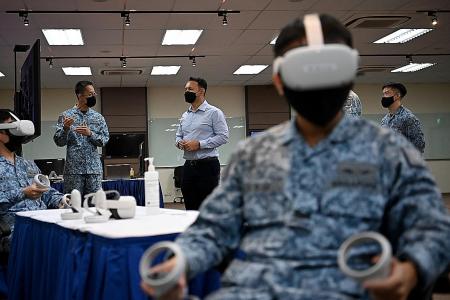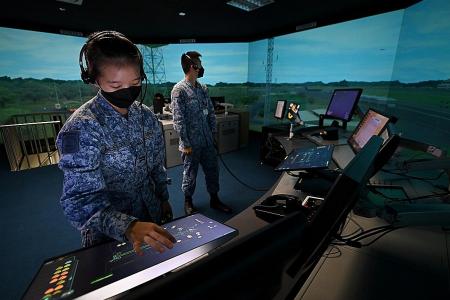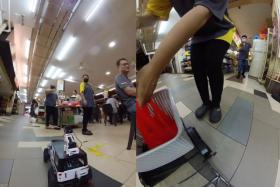RSAF taps tech tools for learner-centric training
Air force improving training outcomes via a virtual reality 'escape room', air traffic control simulator
Other than paper quizzes and oral assessments, technician trainees in the Republic of Singapore Air Force (RSAF) are now also tested through a virtual reality (VR) game.
Trainees don VR headsets to access the newly developed "escape room", where they complete puzzles that test their knowledge and skills, such as on aircraft maintenance tasks, as they advance from one room to the next.
"One advantage is safety," said Third Sergeant Li Mingyang, an air force technician who helped to develop the escape room. "We can afford to make mistakes without fear of severe consequences."
It also injects an element of fun, the 20-year-old full-time national serviceman told reporters yesterday. He added that he has seen trainees bond with their coursemates in lessons he has helped to conduct, as well as build teamwork and communications skills.
Three batches of trainees have used the VR escape room as part of the assessment for their two-month air force technician course at the Air Force Training Command (AFTC) in Paya Lebar since March.
This was among the learning tools showcased yesterday during a visit by Senior Minister of State for Defence Zaqy Mohamad.
The training command provides foundation training for all RSAF airmen and women.
Speaking to reporters after his visit, Mr Zaqy said that the innovations have enabled the RSAF to perform at a high level and brought gamification and realism to the fore.
"Some of these developments have also enabled us to engage our trainees better," he said.
Another VR learning tool demonstrated yesterday trains ground-based air defence crew on the ability to recognise aircraft in the air.
This system is also meant to increase trainee engagement and enable instructors to provide targeted and immediate feedback, said the Ministry of Defence.
The RSAF is also exploring the use of advanced high- fidelity simulators that are paired with biometric sensors to better train and assess pilots.
The system collects "non-invasive psychophysiological" measurements such as eye movement, heart rate and facial expression while the trainee is in the simulator, to gain insights into a trainee's performance.
Senior Lieutenant-Colonel James Phang, 46, who is head of Training Development Group at AFTC, said the move towards more "learner-centric" training programmes began more than 10 years ago.
The younger generation of learners are "digital natives", he said, which means they are comfortable with using mobile platforms and self-directed learning.
"So... we've embarked in a large way to explore the learning technologies available - looking at other militaries, other higher-learning institutes, as well as approaching different companies," he said.
Another learning tool, an air traffic control simulator, provides various virtual environments for realistic training in runway management and control of airborne aircraft within an airbase area.
Set up in 2014, the simulator has been a boon for air traffic control officers in training, such as Lieutenant Denise Looi, 23.
She said a key advantage was the ability to simulate emergency scenarios that are rare in real life.
"Being able to practise how to react quickly, plan and take the necessary mitigation actions - it helps us build confidence and competencies along the way."
Get The New Paper on your phone with the free TNP app. Download from the Apple App Store or Google Play Store now



